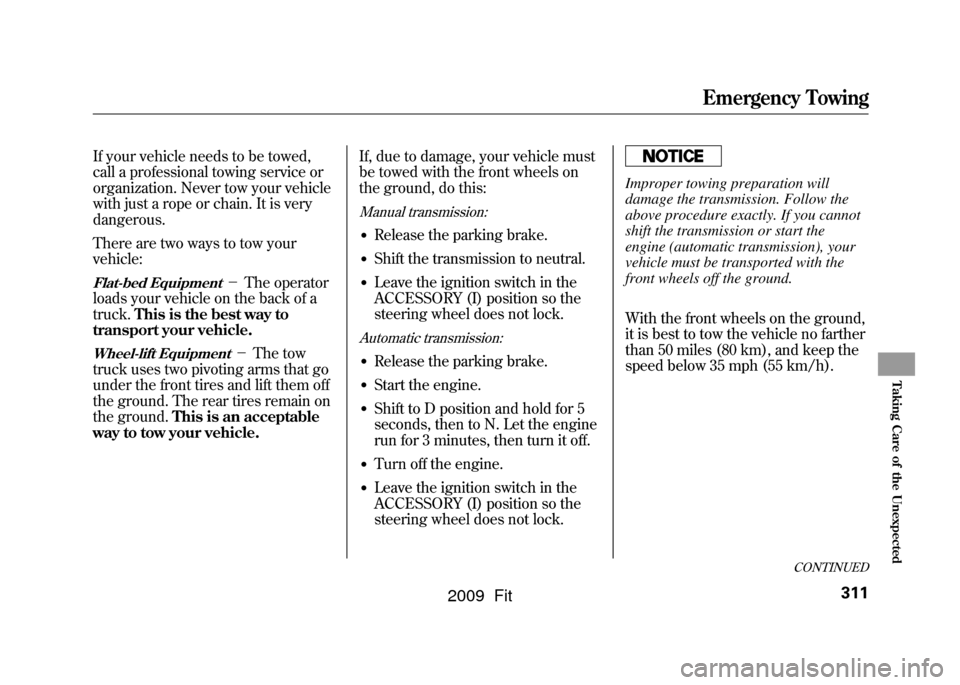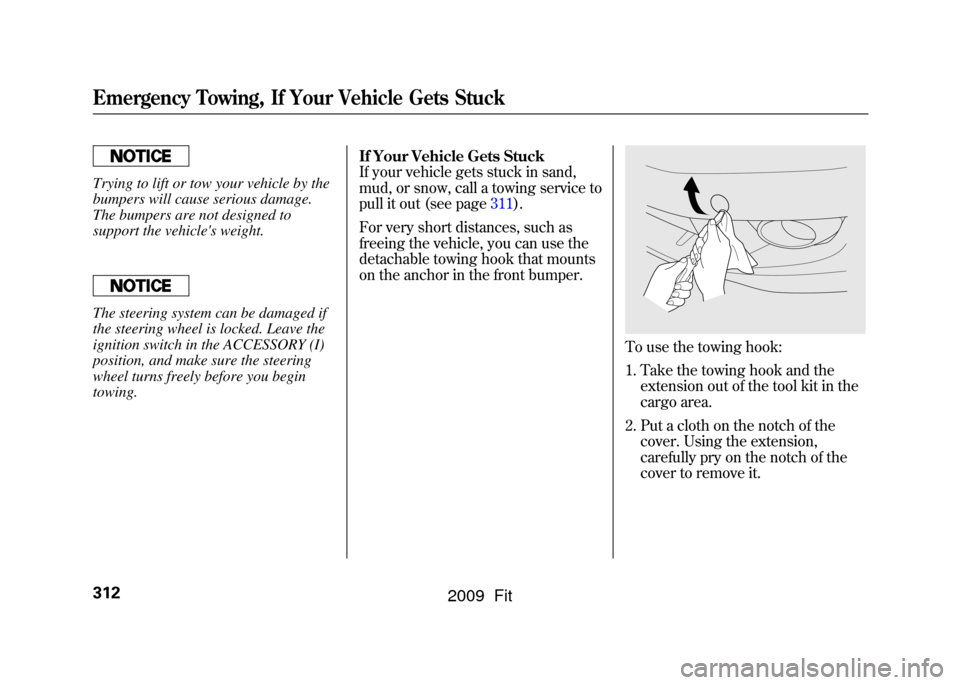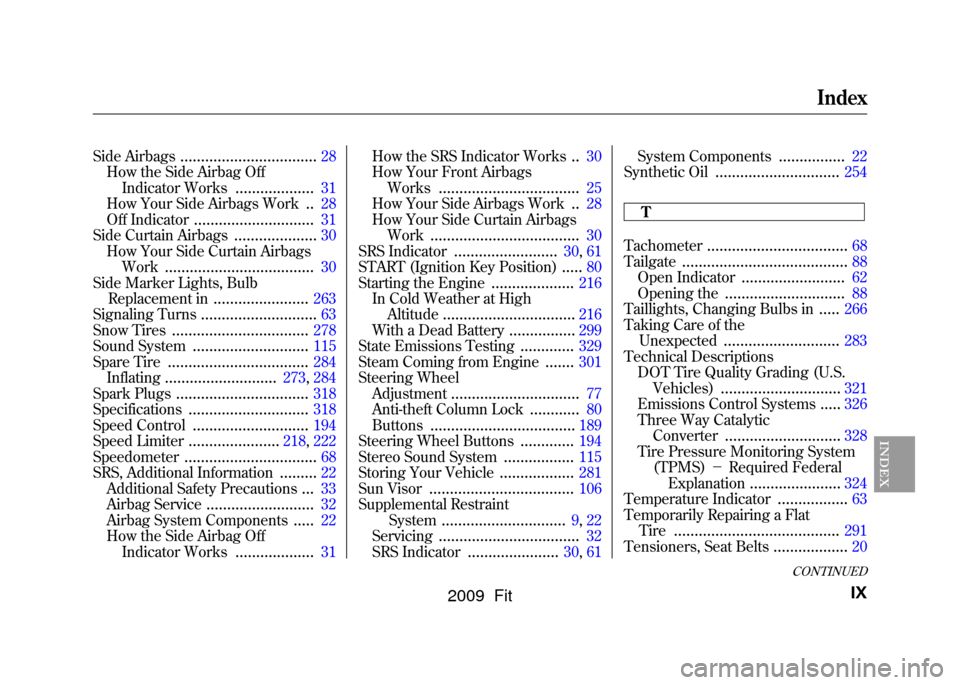2009 HONDA FIT wheel
[x] Cancel search: wheelPage 308 of 352

U.S. Canada
Brake System
Indicator (Red)
The brake system indicator (red)
normally comes on when you turn
the ignition switch to the ON (II)
position, and as a reminder to check
the parking brake. It will stay on if
you do not fully release the parking
brake.
If the brake system indicator (red)
comes on while driving, the brake
fluid level is probably low. Press
lightly on the brake pedal to see if it
feels normal. If it does, check the
brake fluid level the next time you
stop at a service station (see page
261).
If the fluid level is low, take your
vehicle to a dealer, and have the
brake system inspected for leaks or
worn brake pads/shoes. However, if the brake pedal does not
feel normal, you should take
immediate action. A problem in one
part of the system's dual circuit
design will still give you braking at
two wheels. You will feel the brake
pedal go down much farther before
the vehicle begins to slow down, and
you will have to press harder on the
pedal.
Slow down by shifting to a lower
gear, and pull to the side of the road
when it is safe. Because of the long
distance needed to stop, it is
hazardous to drive the vehicle. You
should have it towed and repaired as
soon as possible (see
Emergency
Towing on page 311).
If you must drive the vehicle a short
distance in this condition, drive
slowly and carefully. If the ABS indicator and the VSA
system indicator (if equipped) come
on with the brake system indicator,
have your vehicle inspected by your
dealer immediately.
Brake System Indicator
305
Taking Care of the Unexpected
2009 Fit
Page 314 of 352

If your vehicle needs to be towed,
call a professional towing service or
organization. Never tow your vehicle
with just a rope or chain. It is very
dangerous.
There are two ways to tow your
vehicle:Flat-bed Equipment
-The operator
loads your vehicle on the back of a
truck. This is the best way to
transport your vehicle.
Wheel-lift Equipment
- The tow
truck uses two pivoting arms that go
under the front tires and lift them off
the ground. The rear tires remain on
the ground. This is an acceptable
way to tow your vehicle. If, due to damage, your vehicle must
be towed with the front wheels on
the ground, do this:
Manual transmission:●Release the parking brake.●Shift the transmission to neutral.●Leave the ignition switch in the
ACCESSORY (I) position so the
steering wheel does not lock.
Automatic transmission:●Release the parking brake.●Start the engine.●Shift to D position and hold for 5
seconds, then to N. Let the engine
run for 3 minutes, then turn it off.●Turn off the engine.●Leave the ignition switch in the
ACCESSORY (I) position so the
steering wheel does not lock.
Improper towing preparation will
damage the transmission. Follow the
above procedure exactly. If you cannot
shift the transmission or start the
engine (automatic transmission), your
vehicle must be transported with the
front wheels off the ground.
With the front wheels on the ground,
it is best to tow the vehicle no farther
than 50 miles (80 km), and keep the
speed below 35 mph (55 km/h).
CONTINUED
Emergency Towing
311
Taking Care of the Unexpected
2009 Fit
Page 315 of 352

Trying to lift or tow your vehicle by the
bumpers will cause serious damage.
The bumpers are not designed to
support the vehicle's weight.The steering system can be damaged if
the steering wheel is locked. Leave the
ignition switch in the ACCESSORY (I)
position, and make sure the steering
wheel turns freely before you begin
towing.If Your Vehicle Gets Stuck
If your vehicle gets stuck in sand,
mud, or snow, call a towing service to
pull it out (see page311).
For very short distances, such as
freeing the vehicle, you can use the
detachable towing hook that mounts
on the anchor in the front bumper.
To use the towing hook:
1. Take the towing hook and the
extension out of the tool kit in the
cargo area.
2. Put a cloth on the notch of the cover. Using the extension,
carefully pry on the notch of the
cover to remove it.
Emergency Towing, If Your Vehicle Gets Stuck312
2009 Fit
Page 321 of 352

DimensionsLength 161.6 in (4,105 mm)
Width 66.7 in (1,695 mm)
Height 60.0 in (1,525 mm)
Wheelbase 98.4 in (2,500 mm)
Track Front 58.7 in (1,492 mm)
ꭧ1
58.1 in (1,476 mm)
ꭧ2
Rear 58.1 in (1,475mm)
ꭧ1
57.4 in (1,459 mm)
ꭧ2
ꭧ1: All models except Sport
ꭧ 2: Sport model
Weights Gross vehicle weight rating See the certification label attached to the driver's doorjamb.
Seating Capacities Total 5
Front 2
Rear 3Engine
Type Water cooled 4-stroke SOHC
i-VTEC 4-cylinder gasoline engine
Bore x Stroke 2.87 x 3.52 in
(73.0 x 89.4 mm)
Displacement 91.3 cu-in (1,497 cm
3)
Compression ratio 10.4 : 1
Spark plugs IZFR6K13 (NGK)
SKJ20DR-M13 (DENSO)
Specifications318
2009 Fit
Page 325 of 352

Temperature
The temperature grades are A (the
highest), B, and C, representing the
tire's resistance to the generation of
heat and its ability to dissipate heat
when tested under controlled
conditions on a specified indoor
laboratory test wheel. Sustained high
temperature can cause the material
of the tire to degenerate and reduce
tire life, and excessive temperature
can lead to sudden tire failure. The
grade C corresponds to a level of
performance which all passenger car
tires must meet under the Federal
Motor Vehicle Safety Standard No.
109. Grades B and A represent
higher levels of performance on the
laboratory test wheel than the
minimum required by law.Warning: The temperature grade for
this tire is established for a tire that
is properly inflated and not
overloaded. Excessive speed,
underinflation, or excessive loading,
either separately or in combination,
can cause heat buildup and possible
tire failure.DOT Tire Quality Grading (U.S. Vehicles)322
2009 Fit
Page 328 of 352

Your vehicle has also been equipped
with a TPMS malfunction indicator to
indicate when the system is not
operating properly. The TPMS
malfunction indicator is provided by
a separate telltale, which displays the
symbol‘‘TPMS ’’when illuminated.
When the malfunction indicator is
illuminated,the system may not be able to detect
or signal low tire pressure as
intended.
TPMS malfunctions may occur for a
variety of reasons, including the
installation of replacement or
alternate tires or wheels on the
vehicle that prevent the TPMS from
functioning properly. Always check the TPMS malfunction
telltale after replacing one or more
tires or wheels on your vehicle to
ensure that the replacement or
alternate tires and wheels allow the
TPMS to continue to function
properly.
Tire Pressure Monitoring System (TPMS)
-Required Federal Explanation
325
Technical Information
2009 Fit
Page 340 of 352

A
AAABBB ~CCC
.................................
3
Accessories and Modifications
..........................
206
ACCESSORY (Ignition Key Position)
...................................
80
Accessory Power Socket
............
106
Additives, Engine Oil
.................
254
Adjusting the Steering Wheel
......
77
Advanced Airbags
........................
27
Airbag (SRS)
............................
9, 22
Air Conditioning System
............
110
Usage
......................................
111
Air Pressure, Tires
..............
273, 274
Alcohol in Gasoline
....................
198
Antifreeze
...................................
256
Anti-lock Brakes (ABS) Indicator Light
..................
62, 231
Operation
................................
231
Anti-theft, Audio System
.............
191
Anti-theft Steering Column Lock
.........................................
80
Audio System
.............................
115 Auto Control Mode, Starting
Engine
....................................
216
Auto Door Locking
.......................
83
Auto Door Locking/Unlocking
....
83
Auto Door Unlocking
...................
85
Automatic Seat Belt Tensioners
...
20
Automatic Speed Control
...........
194
Automatic Transmission
............
219
Capacity, Fluid
........................
319
Checking Fluid Level
..............
259
Paddle Shifters
........................
224
Shifting
...................................
219
Shift Lever Position Indicators
............................
219
Shift Lever Positions
...............
220
Shift Lock Release
...................
223
Automatic Transmission Fluid
...
259
Auxiliary Input Jack
...................
190
Average Fuel Mileage
..................
70
B
Battery Charging System Indicator
........................
60, 303 Jump Starting
..........................
299
Maintenance
...........................
279
Specifications
..........................
320
Before Driving
...........................
197
Belts, Seat
................................
8, 18
Beverage Holders
......................
106
Booster Seats
...............................
50
Brakes Anti-lock Brakes (ABS)
...........
231
Break-in, New Linings
.............
198
Bulb Replacement
...................
266
Fluid
.......................................
261
Parking
...................................
102
System Design
........................
230
System Indicator
...............
60, 305
Wear Indicators
.......................
230
Braking System
..........................
230
Break-in, New Vehicle
................
198
Brightness Control, Instruments
..............................
76
CONTINUED
Index
I
INDEX
2009 Fit
Page 348 of 352

Side Airbags
.................................
28
How the Side Airbag Off Indicator Works
...................
31
How Your Side Airbags Work
..
28
Off Indicator
.............................
31
Side Curtain Airbags
....................
30
How Your Side Curtain Airbags Work
....................................
30
Side Marker Lights, Bulb Replacement in
.......................
263
Signaling Turns
............................
63
Snow Tires
.................................
278
Sound System
............................
115
Spare Tire
..................................
284
Inflating
...........................
273, 284
Spark Plugs
................................
318
Specifications
.............................
318
Speed Control
............................
194
Speed Limiter
......................
218, 222
Speedometer
................................
68
SRS, Additional Information
.........
22
Additional Safety Precautions
...
33
Airbag Service
..........................
32
Airbag System Components
.....
22
How the Side Airbag Off Indicator Works
...................
31 How the SRS Indicator Works
..
30
How Your Front Airbags Works
..................................
25
How Your Side Airbags Work
..
28
How Your Side Curtain Airbags Work
....................................
30
SRS Indicator
.........................
30, 61
START (Ignition Key Position).....
80
Starting the Engine
....................
216
In Cold Weather at High Altitude
................................
216
With a Dead Battery
................
299
State Emissions Testing
.............
329
Steam Coming from Engine
.......
301
Steering Wheel Adjustment
...............................
77
Anti-theft Column Lock
............
80
Buttons
...................................
189
Steering Wheel Buttons
.............
194
Stereo Sound System
.................
115
Storing Your Vehicle
..................
281
Sun Visor
...................................
106
Supplemental Restraint
System
..............................
9,22
Servicing
..................................
32
SRS Indicator
......................
30, 61 System Components
................
22
Synthetic Oil
..............................
254
T
Tachometer
..................................
68
Tailgate
........................................
88
Open Indicator
.........................
62
Opening the
.............................
88
Taillights, Changing Bulbs in
.....
266
Taking Care of the Unexpected
............................
283
Technical Descriptions DOT Tire Quality Grading (U.S. Vehicles)
.............................
321
Emissions Control Systems
.....
326
Three Way Catalytic Converter
............................
328
Tire Pressure Monitoring System (TPMS) -Required Federal
Explanation
......................
324
Temperature Indicator
.................
63
Temporarily Repairing a Flat Tire
........................................
291
Tensioners, Seat Belts
..................
20
CONTINUED
Index
IX
INDEX
2009 Fit